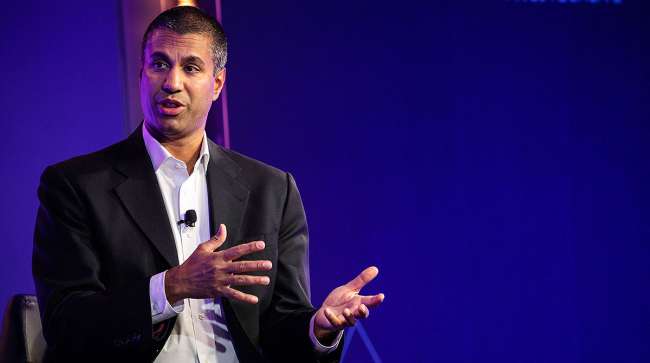Bloomberg News
Automakers Stand to Lose Airwaves Rights as FCC Drops a Promise

[Stay on top of transportation news: Get TTNews in your inbox.]
Federal Communications Commission Chairman Ajit Pai proposed reassigning airwaves long promised to automakers and instead allow other wireless uses on the frequencies.
Pai set a Dec. 12 vote by the commission on the proposal to modify the grant of airwaves the agency made 20 years ago.
Chairman Pai’s new 5.9 GHz proposal was outlined in a speech delivered earlier today and available at: https://t.co/SYPdNA1OEf
— The FCC (@FCC) November 20, 2019
The FCC vote would request comments on letting Wi-Fi gadgets occupy part of the airwaves while letting automakers utilize the remainder of the swath. So far automakers have had exclusive rights to the entire frequency band for a technology they’ve barely used.
“We want to move on from something we’ve tried for a long time that wasn’t working, and open the door to new and exciting opportunities,” Pai said in a speech at a Washington event. “After 20 years of seeing these prime airwaves go largely unused, the time has come for the FCC to take a fresh look.”
The change wouldn’t be final until another vote by the FCC, which under Pai has worked to free airwaves bands for new uses. Because Pai leads a Republican majority, his proposals usually pass.
Cable providers who offer Wi-Fi for customers’ wireless use are hungry for spectrum as digital technology transforms everything from cars to video feeds and household appliances.
More airwaves are needed to help “deliver a future of ubiquitous connectivity,” Charter Communications Inc. said in a Nov. 12 filing. Charter’s network supports more than 300 million devices, the Stamford, Conn.-based company said.
The airwaves could be used for fast communications including machine-to-machine links, and smart city applications such as smart cameras, traffic monitoring and security sensors, NCTA-The Internet & Television Association, a trade group for companies including Comcast Corp. and Charter, told the FCC in a Sept. 25 filing.
Today's announcement by @AjitPaiFCC marks an exciting development in delivering the gigabit future on Wi-Fi https://t.co/UN03eAJW2y — NCTA - The Internet & Television Association (@NCTAitv) November 20, 2019
Auto industry companies including General Motors Co., Toyota Motor Corp. and Denso Corp. spent more than a decade developing a communications system that would use the airwaves. The technology called vehicle-to-vehicle, or “V2V,” links cars, roadside beacons and traffic lights into a seamless wireless web to avoid collisions and heed speed limits. Yet deployments have been few, and no major automakers produce cars using the technology in the U.S.
The auto industry has broadly shifted to favor a newer technology based on cellular systems. Ford Motor Co., for instance, announced earlier this year that it will outfit all its new U.S. models starting in 2022 with cellular vehicle-to-everything technology. The system would enable Ford’s cars to communicate with one another about road hazards, send signals to stoplights to smooth traffic flow and pay fast-food bills automatically while picking up meals.
Automakers and their allies last year asked the FCC to let them use part of the band for cellular-based technology — rather than the Wi-Fi format the agency mandated in 1999 — while preserving all of the airwaves for transportation safety. In a petition the companies said the newer, cellular technology is more reliable, with greater range.
Pai’s proposal would let the newer, cellular technology use some of the airwaves in question.
The Transportation Department in a statement Nov. 20 said it hadn’t changed its position that the entire airwaves swath needs to be retained for auto safety.
.@USDOT has clearly stated in testimony and correspondence that the 75 MHz allocated in the 5.9 GHz, what we call the “Safety Band”, must be preserved for transportation safety purposes. https://t.co/yKpFzFj6BE — USDOT Research (@Research_USDOT) November 20, 2019
“We’re hoping to preserve that 75 megahertz because it is now time, the technology is now there, that we can start deploying this potentially life-saving technology,” James Owens, acting administrator of the National Highway Traffic Safety Administration, said in a Senate hearing.
ITS America, a trade group that includes Ford and GM, said in a statement, “In a country that reels from nearly 36,000 roadway deaths every year, it is unfathomable that the United States would literally give away our top safety tool — and with it, our best chance to save tens of thousands of lives.”
With assistance from Keith Naughton.
Want more news? Listen to today's daily briefing:


